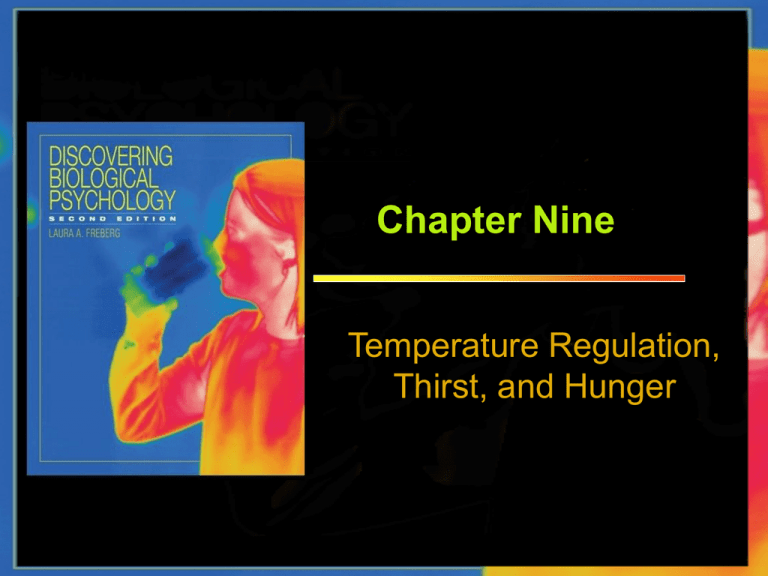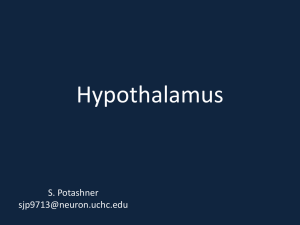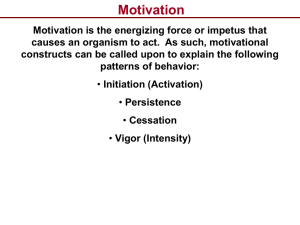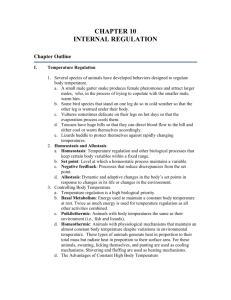Temperature Regulation, Thirst, and Hunger Presentation
advertisement

Chapter Nine Temperature Regulation, Thirst, and Hunger CHAPTER 9 TEMPERATURE REGULATION, THIRST, AND HUNGER Homeostasis • Homeostasis: Physiological equilibrium • Motivation: Activating and directing behavior • Regulation of Body Temperature – Set point – Mechanisms for detecting deviation – Internal and behavioral elements to regain set point • Adaptations to Temperature – Endotherms – Ectotherms Figure 9.2 Surface-to-Volume Ratios Affect Temperature Regulation Homeostasis • Behavioral Responses to Heat and Cold – Ectotherms more dependent on behavioral devices – Changes in position, weight, color and composition of fur • Endothermic Responses to Heat and Cold – Automatic internal response to deviations in temperature • Responses to lower temperatures – Shiver – Blood vessels constrict – Thyroid hormone increase • Responses to lower temperatures – Perspiration, licking – Blood vessels dilate Homeostasis • Deviations in Human Core Temperature – Fever – Heat stroke (hyperthermia) – Hypothermia • Brain Mechanisms for Temperature Regulation – POA of the hypothalamus, anterior hypothalamus and septum • Temperature Regulation in Infancy – Relatively helpless in adapting to temperature Figure 9.7 The Hypothalamus Controls Temperature Regulation Thirst: Regulation of the Body’s Fluid • Intracellular and Extracellular Fluids – Extracellular fluid (33%) – Intracellular fluid (67%) • Osmosis Causes Water to Move – Water moves from an area with lower concentration of solutes to an area with higher concentration – Hypotonic versus hypertonic • The Role of the Kidneys – Excretes excess fluids and sodium Figure 9.8 The Body’s Fluids Are Held in Three Compartments Figure 9.9 Osmosis Causes Water to Move Thirst: Regulation of the Body’s Fluid • The Sensation of Thirst – Occurs as a result of osmotic (drops in the intracellular fluid volume) and hypovolemic (drops in blood volume) thirst • Mechanisms of Osmotic Thirst – Osmoreceptors located in the brain – Organum vasculosum of the lamina terminalis (OVLT) • Mechanisms of Hypovolemic Thirst – Baroreceptors measure blood pressure – Receptors in the heart and kidneys Table 9.1 Sources of Typical Daily Fluid Loss and Intake in Humans Figure 9.10 Detecting Osmotic Thirst Thirst: Regulation of the Body’s Fluid • Hormones, Sodium, and Thirst – Antidiuretic hormone (ADH) or vasopressin – Low blood volume stimulates hunger for sodium • Initiation of Drinking – Begins when angiotensin II acts on subfornical organ (SFO) • Cessation of Drinking – Fluid receptors in mouth, throat, digestive system – Hyponatremia Figure 9.11 Antidiuretic Hormone Begins a Sequence of Events Leading to Fluid Conservation Thirst: Regulation of the Body’s Fluid • Thirst and Sports Drinks – Provides more sodium than other beverages, which helps athletes retain fluids and may prevent hyponatremia Hunger • The Influence of Culture on Food Choices – Learned food preferences begin early in life • The Process of Digestion – Foods are broken down into usable chemicals by the digestive tract – During digestion fats, proteins, and carbohydrates are absorbed into the blood supply and circulated to waiting tissues – The brain uses glucose for energy Figure 9.13 Lactose Tolerance Correlates with Use of Dairy Products Figure 9.14 The Major Structures of the Digestive Tract Hunger • The Pancreatic Hormones – Glucagon converts stored glycogen back into glucose – Insulin helps store glucose as glycogen and assists in moving glucose from the blood supply into body cells – Type 1 diabetes mellitus – Type 2 diabetes mellitus Figure 9.15 Insulin Release is Reduced in Type 2 Diabetes Hunger • The Initiation of Eating – Affected by blood glucose levels and low fat levels – Receptors and Hunger • Glucoreceptors in nucleus of the solitary tract (NST) – Brain Mechanisms for Hunger • Lateral hypothalamus (LH) – Neurochemicals and Hunger • Leptin communicates with neurons in the arcuate nucleus of the hypothalamus (NPY and AgRP) • Ghrelin • Orexins Figure 9.17 Hypothalamic Nuclei Participate in the Control of Hunger Hunger • Satiety – Assessing Satiety • Stomach fullness, intestines, CCK – Brain Mechanisms for Satiety • Ventromedial hypothalamus (VMH) • Paraventricular nucleus (PVN) • Nucleus of the solitary tract (NST) – Neurochemicals and Satiety • Leptin found in blood when body fat levels high • αMSH and CART Figure 9.18 Weight Gain in VMH Syndrome Figure 9.19 Neurochemical Correlates of Hunger and Satiety Obesity and Eating Disorders • Defining Normal Weight – Body mass index (BMI) – Body fat measurement • Obesity – Stress and high fat diet increase release of NPY and appetite – Defending the Obese Weight • Diet reduces size of individual fat cells but not the number of fat cells – Interventions for obesity • Weight loss diets reduce calories consumed Figure 9.20 Body Mass Index Provides a Measure of Ideal Weight Figure 9.21 The Submersion Test of Body Composition Obesity and Eating Disorders • Anorexia Nervosa – Maintain 85% or less of normal weight • Bulimia Nervosa – Cyclical pattern of binge eating and purging • Causes for Anorexia and Bulimia – Media images – Biological factors – Addictive processes • Treatment for Eating Disorders – Antidepressants, cognitive behavioral therapy











